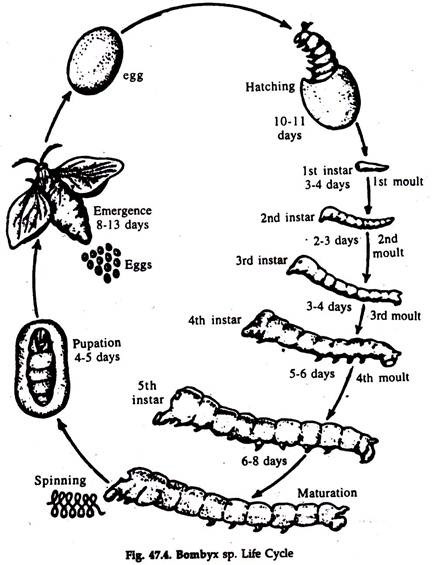In this article we will discuss about the life cycle and culture of bombyx mori, explained with the help of suitable diagrams.
Life Cycle of Bombyx Mori:
Adult:
The adult moth is whitish in colour, 25 mm long with 40 to 50 mm wing span. The female is larger than the male. The body has three divisions—head with a pair of eyes and a pair of antennae, thorax with three pairs of legs and two pairs of wings, and one large abdomen.
ADVERTISEMENTS:
Egg:
Immediately after mating the female starts laying eggs on mulberry leaves. The eggs are oval and covered by a hard, smooth chitinoid shell. At about 24°C a moth lays 300 to 500 eggs within 24 hours. In favourable temperature the larvae hatch out within 10 to 11 days.
Larva:
1. A newly hatched larva is about 3 mm long. The cylindrical body is covered with a chitinous skin and divided into 13 (or 14) segments, with a head at the anterior end and a caudal horn near the posterior end of the body.
ADVERTISEMENTS:
2. It has three pairs of thoracic, four pairs of abdominal and a pair of caudal legs.
3. The larva goes to dormancy or diapause for four times. These are called 1st, 2nd, 3rd and 4th ‘sleeps.’
4. Each ‘sleep’ is followed by ecdysis. The part of life in between hatching and first ecdysis is 1st stage, and between the first and second ecdysis the 2nd stage and so on.
5. Towards the end of 5th stage, the larva is mature and starts spinning cocoon. The larval age is about 20 days.
ADVERTISEMENTS:
6. The first instar (newly hatched larva) is a voracious eater, and is fed with finely cut, young mulberry leaves. Advance larvae are fed with matured and entire leaves.
7. The 1st instar eats for three days, stops eating and moults to 2nd instar.
8. The 2nd instar eats for 2½ days and moults to 3rd instar.
9. After eating for three days the 3rd instar moults to 4th instar.
10. The 5th instar is formed after eating for 4 days.
11. The 5th instar eats for eight days, ceases to eat and starts spinning silk around it from outside to inside.
12. For a complete covering the larva rotates its head about 60,000 to 300,000 times and the silk thread is liberated at the rate of 15 cm per minute.
13. The protective Covering is called cocoon which is formed by an unbroken silk thread 400 to 1,500 metres.
14. A caterpillar larva takes about 4 days to complete a cocoon and then turns to a completely immobile larva, the pupa.
ADVERTISEMENTS:
15. The pupa is transformed into a full grown adult or imago after ten days.
16. The imago secretes a fluid which dissolves the cocoon at one end and the adult emerges through it.
Culture of Bombyx Mori:
1. The moth is made to lay eggs, on a Wotting paper. The eggs are collected and treated with 2% formaldehyde.
2. The larvae hatch out within 10 to 11 days. They are reared in bamboo trays and strict hygiene is maintained. The larva is about 3 mm long and called 1st instar.
3. The larvae are voracious eaters. Chopped, young mulberry leaves are given as food in the beginning, but with advanced age, entire and matured leaves are supplied.
4. The 1st, 2nd, 3rd, 4th and 5th ins tars eat for 3, 2½, 3, 5 and 8 days, respectively.
5. The 5th instar starts spinning silk thread around its body from outside to inside and encloses itself within four days in a cocoon of a continuous silk thread.
6. Before cocoon formation, matured larvae are transferred to special trays known as spinning trays.
7. The cocoon are treated with hot water to kill the pupae within them and processed for getting raw silk.
8. For next crop, healthy cocoons are selected during harvest and kept in well- ventilated cages for emergence of adults.
